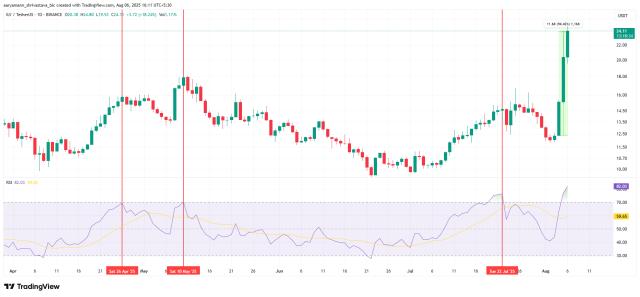The on-chain circulation speed of Bit is at its lowest level in a decade, indicating that its use has shifted from currency to long-term asset holding. The institutional adoption rate has increased, with significant increases in BTC holdings in exchange-traded funds (ETFs) and corporate treasuries, thereby reducing on-chain transactions.
Off-chain activities, including Lightning Network and Wrapped Bitcoin usage, show that BTC's economic activity is more active than on-chain indicators suggest.
The on-chain transaction speed of Bit (i.e., its circulation speed) is at its lowest level in a decade. To some, this is a dangerous signal: Has Bit lost its momentum? Is it still being used?
In fact, the decline in circulation speed may be the clearest signal yet that Bit is maturing, rather than stagnating. Bit is no longer circulating like cash, but increasingly being held like gold.
Functional Change
In traditional economics, circulation speed refers to how frequently money changes hands; it is an indicator of economic activity. For Bit, it tracks the frequency of on-chain transactions. In Bit's early development stages, with traders, early adopters, and enthusiasts testing its use cases, its circulation frequency was high. During major bull markets in 2013, 2017, and 2021, transaction activity surged, with Bit moving quickly between wallets and exchanges.
Today, the situation has changed. Over 70% of Bit has not moved in more than a year. Transaction activity has decreased. At first glance, this seems to indicate reduced usage. But in reality, it reflects something else: steadfast confidence. Bit is being viewed as a long-term asset, not just a short-term currency. This shift is largely driven by institutions.
Institutional Adoption Leading to Supply Lock
Since the launch of US spot Bit ETFs in 2024, institutional holdings have significantly increased. By mid-2025, spot ETFs hold over 1.298 million Bit, about 6.2% of total circulating supply. Including corporate treasuries, private companies, and investment funds, total institutional holdings are close to 2.55 million Bit, approximately 12.8% of all circulating Bit. These assets mostly remain unchanged, stored in cold wallets as part of a long-term strategy. Companies like Strategy and Tesla have not used their Bit, instead holding it as strategic reserves.
This is positive for scarcity and price, but simultaneously reduces circulation speed: the amount in circulation decreases, and on-chain transactions reduce.
Off-Chain Usage Increasing and Harder to Observe
It's important to note that on-chain circulation speed does not cover all of Bit's economic activities.
On-chain circulation speed only tells part of the story. Today, Bit's true economic activity increasingly occurs beyond the base layer and outside traditional measurement methods.
Take the Lightning Network, for example, a second-layer scaling solution for Bit that can completely bypass the main chain for fast, low-cost payments. From streaming micropayments to cross-border remittances, the Lightning Network enables Bit's use in daily scenarios, but these transactions are not reflected in circulation speed indicators. By mid-2025, the Lightning Network's public capacity exceeded 5,000 Bit, growing nearly 400% since 2020. The growth of private channels and institutional experiments suggest the actual numbers are much higher.
Similarly, Wrapped Bitcoin (WBTC) enables Bit to circulate on Ethereum and other chains, powering DeFi protocols and tokenized finance. In just the first half of 2025, WBTC's supply grew by 34%, clearly showing Bit is being used, not idle.
Then there's the custody issue: institutional wallets, ETF cold storage, and multisig financial tools allow enterprises to hold Bit securely but typically not transfer these coins. These coins may have significant economic meaning but contribute nothing to on-chain transaction speed.
In short, Bit's activity might be higher than it appears, just occurring beyond traditional circulation speed indicators. Its utility is shifting to new levels and platforms—payment channels, smart contract systems, yield strategies—none of which are reflected in traditional circulation speed models. As Bit evolves into a multi-layered monetary system, we may need new methods to measure its momentum. The decline in on-chain circulation speed doesn't necessarily mean usage is decreasing. In fact, it might just mean we're looking in the wrong direction.
Trade-offs Behind Low Transaction Speed
While slow transaction speed indicates investor confidence and long-term holding, it also brings challenges. Reduced on-chain transactions mean fewer fees for miners: this has become an increasingly serious problem after the 2024 block reward halving. Bit's long-term security model depends on a healthy fee market, which requires ongoing economic activity.
There's also a perception issue. In a network with few coins circulating, it might start to look more like a static vault than an active market. This might strengthen the "digital gold" argument for Bit but weaken its vision as a circulating currency.
This is the core design contradiction: Bitcoin aims to simultaneously serve as a store of value (digital gold) and a medium of exchange (peer-to-peer cash). However, these two roles are not always harmonious. Circulation speed is an indicator of this push-and-pull relationship, and the ongoing struggle between preservation and utility, as well as how Bitcoin addresses this situation, will not only affect its usage patterns but also determine its role in the broader financial system.
Signs of Maturity
Ultimately, the decline in Bitcoin's circulation speed does not mean a decrease in its usage frequency. It indicates that people's methods of using Bitcoin have changed. As Bitcoin's value increases, people are more inclined to save it rather than spend it. As its infrastructure gradually shifts to off-chain, and with the entry of institutions focusing more on value preservation than circulation, the Bitcoin network is evolving. Circulation speed has not disappeared; it has simply become less active, reshaped by changing user groups and new economic activity levels.
If transaction speed rises again, it may signal a resurgence of transactional use, with increased consumption, faster fund flow, and higher retail participation. If transaction speed remains low, it indicates that Bitcoin's role as a macro collateral has become deeply entrenched. Regardless of the scenario, transaction speed provides a window of observation for Bitcoin's future. It is not a currency for consumption but an asset that can be constructed.








